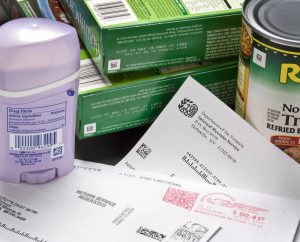People often ask us why they should use 2D barcodes—the small, patterned squares that are showing up more frequently on products, advertisements, signs, and more.
The answer to “why” is usually paired with “how.” In some applications, this technology can seem a little dated, but the truth is that 2D barcodes are now an integral part of data collection processes. Coupled with modern scanning technology, the 2D barcode can be a good choice for warehouses, manufacturers, mobile field work, and more.
A QR code is a 2D barcode that originated with Denso Wave, a subsidiary of Toyota, to track vehicles through assembly. It was later followed by a Data Matrix 2D code, PDF417, and Aztec. QR and Data Matrix are most commonly used for retail, manufacturing, logistics, government, entertainment, healthcare, marketing, and advertising. The PDF417 can hold more the1.1 KB of data and is often used for photos, fingerprints, signatures, and graphics. The Aztec has been adopted by airlines for boarding passes.
Linear barcodes (1D), simply couldn’t carry enough data (about 20-25 characters). 2D barcodes can store up to 4,000 characters.
The “why” and “how”
A 1D barcode provides information. Think of a 2D barcode as a guide. A scan of this barcode takes you to a landing page, website, brochure, contact information, instruction manual, coupon, special offer, article, social media page, or other digital content.
As a marketing, sales, or technical support tool, a QR code or Data Matrix code makes it easy for your customers to connect with you. And when they scan the code, you collect important data to follow the traffic.
Here are some ways that businesses are using 2D barcodes:
- Business card or convention nametag, which connects to the company’s website or the professional’s contact information and LinkedIn profile.
- Signs on trucks, trailers, property for sale, and at promotional venues
- Brochures, posters, ads, and promotional materials
- Point-of-sale receipts that direct the user to a survey, prize drawing, special offer, or coupon
- Product packaging and tags, to provide additional information, including warranty registration, installation help, and troubleshooting instructions
- Patient wristbands and medications
- Event tickets and boarding passes
- Event invitation to direct the guest to RSVP or registration page
Most smartphones can scan a 2D code, either using the phone’s camera or a mobile app. Businesses that rely on automated data collection require a heavy volume of scanning, so we recommend the use of a 2D scanner, which can read both 1D and 2D barcodes. For the broadest variety of 2D imagers, we recommend Zebra, for the durability, performance, and ease of use.
When you’re ready to take advantage of QR codes for your business, talk to us at Informs. We have offices throughout the United States, ensuring you get personal service, no matter when you call.


Recent Comments